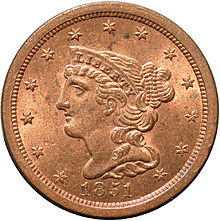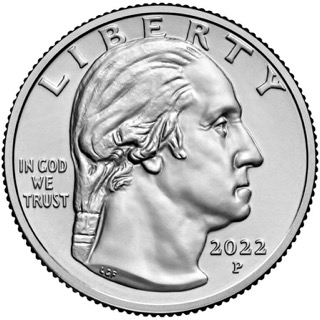
The quarter, formally known as the quarter dollar, is a denomination of currency in the United States valued at 25 cents, representing one-quarter of a dollar. Adorning its obverse is the profile of George Washington, while its reverse design has undergone frequent changes since 1998. Since its initial production in 1796, the quarter dollar has held a significant place in American numismatics, with consistent production since 1831.

The cent, the United States of America one-cent coin, often called the "penny", is a unit of currency equaling one one-hundredth of a United States of America dollar. It has been the lowest face-value physical unit of U.S. currency since the abolition of the half-cent in 1857. The first U.S. cent was produced in 1787, and the cent has been issued primarily as a copper or copper-plated coin throughout its history. Due to inflation, pennies have lost virtually all their purchasing power and are often viewed as an expensive burden to businesses, banks, government and the public in general.
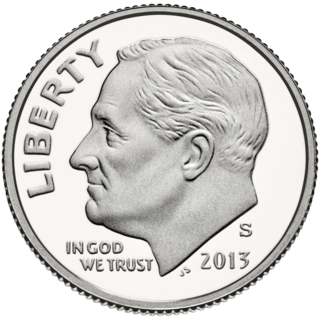
The dime, in United States usage, is a ten-cent coin, one tenth of a United States dollar, labeled formally as "one dime". The denomination was first authorized by the Coinage Act of 1792.
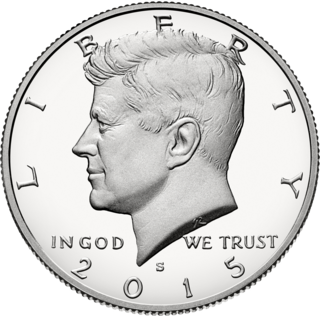
The half dollar, sometimes referred to as the half for short or 50-cent piece, is a United States coin worth 50 cents, or one half of a dollar. In both size and weight, it is the largest United States circulating coin currently produced, being 1.205 inches in diameter and 0.085 in (2.16 mm) in thickness, and is twice the weight of the quarter. The coin's design has undergone a number of changes throughout its history. Since 1964, the half dollar depicts the profile of President John F. Kennedy on the obverse and the seal of the president of the United States on the reverse.
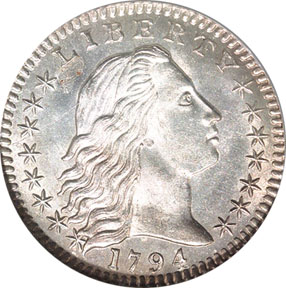
The half dime, or half disme, was a silver coin, valued at five cents, formerly minted in the United States.
Robert Scot (October 2, 1745 – November 3, 1823) was a Scottish-American engraver who served as Chief Engraver of the United States Mint from 1793 until his death in 1823. He was succeeded by William Kneass. Scot designed the popular and rare Flowing Hair dollar coinage along with the Liberty Cap half cent. Scot is perhaps best known for his design, the Draped Bust, which was used on many silver and copper coins. Robert Scot was the most prolific engraver of early American patriotic iconography, with symbols and images depicting rebellion, unity, victory, and liberty throughout his career in America.

The Gobrecht dollar, minted from 1836 to 1839, was the first silver dollar struck for circulation by the United States Mint after production of that denomination had been halted in 1806. The coin was struck in small numbers to determine whether the reintroduced silver dollar would be well received by the public.
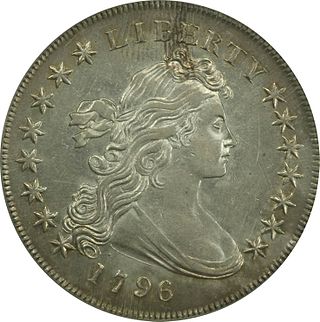
The Draped Bust dollar is a United States dollar coin minted from 1795 to 1803, and was reproduced, dated 1804, into the 1850s. The design succeeded the Flowing Hair dollar, which began mintage in 1794 and was the first silver dollar struck by the United States Mint. The designer is unknown, though the distinction is usually credited to artist Gilbert Stuart. The model is also unknown, though Ann Willing Bingham has been suggested.

The Flowing Hair dollar was the first dollar coin issued by the United States federal government. The coin was minted in 1794 and 1795; its size and weight were based on the Spanish dollar, which was popular in trade throughout the Americas.

The United States large cent was a coin with a face value of 1/100 of a United States dollar. Its nominal diameter was 11⁄8 inch (28.57 mm). The first official mintage of the large cent was in 1793, and its production continued until 1857, when it was officially replaced by the modern-size one-cent coin.

The quarter eagle was a gold coin issued by the United States with a value of two hundred and fifty cents, or two dollars and fifty cents. It was given its name in the Coinage Act of 1792, as a derivation from the US ten-dollar eagle coin.

The three-dollar piece was a gold coin produced by the United States Bureau of the Mint from 1854 to 1889. Authorized by the Act of February 21, 1853, the coin was designed by Mint Chief Engraver James B. Longacre. The obverse bears a representation of Lady Liberty wearing a headdress of a Native American princess and the reverse a wreath of corn, wheat, cotton, and tobacco.
A type set is a coin collection based on coin design or type. Traditional collections consist of all dates within a series such as state quarters or Lincoln cent.

"Draped Bust" was the name given to a design of United States coins. It appeared on much of the regular-issue copper and silver United States coinage, 1796–1807. It was designed by engraver Robert Scot.

The Liberty Cap large cent was a type of large cent struck by the United States Mint from 1793 until 1796, when it was replaced by the Draped Bust large cent. The coin features an image of the goddess of Liberty and her accompanying Phrygian cap.

The Coronet large cent was a type of large cent issued by the United States Mint at the Philadelphia Mint from 1816 until 1857.

The Turban Head eagle, also known as the Capped Bust eagle, was a ten-dollar gold piece, or eagle, struck by the United States Mint from 1795 to 1804. The piece was designed by Robert Scot, and was the first in the eagle series, which continued until the Mint ceased striking gold coins for circulation in 1933. The common name is a misnomer; Liberty does not wear a turban but a cap, believed by some to be a pileus or Phrygian cap : her hair twisting around the headgear makes it resemble a turban.
Flowing Hair coinage was issued in the United States between 1793 and 1795. The design was used for the first half dime, half dollar, dollar, and the first two large cents.
Below are the mintage figures for the United States quarter.

The Liberty Cap half cent was the first half cent coin produced by the United States Mint. It was issued from 1793 until 1797.
